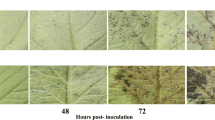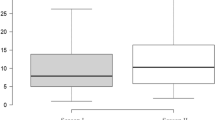Abstract
Twenty tomato (Solanum lycopersicon) cultivars were screened for resistance against bacterial spot disease incited byXanthomonas axonopodis pv.vesicatoria under field conditions with and without pathogen infection. Screening was done by artificially inoculating aX. axonopodis pv.vesicatoria suspension to 4-week-old tomato seedlings and observing them for typical symptoms of the disease. Seedlings were categorized into highly resistant, resistant, susceptible and highly susceptible cultivars on the basis of disease incidence. Tomato cultivars were screened for defense-related enzymes, total phenols and lignin contents. The temporal patterns of all these enzymes were estimated with a moderately susceptible tomato cultivar. Native PAGE analysis of both peroxidase (POX) and polyphenol oxidase (PPO) was carried out for the time course of enzyme activities and also by selecting three different tomato cultivars, following infection with the pathogen. Based on the inducible amounts of these enzymes upon pathogen infection, the tomato cultivars were correlated with the disease incidence under field conditions. A significant (P≤0.05) correlation was observed between the degree of host resistance and the enzyme levels. In highly resistant tomato cultivars the enzyme levels, total phenols and lignin contents were increased in comparison with highly susceptible tomato cultivars. Isoform analysis of POX and PPO enzymes indicated a clear difference between resistant and susceptible tomato cultivars in the number of isoforms and also in the intensity of each isoform in the presence of pathogen infection. The possible regulation of defense-related enzymes in imparting host resistance is discussed.
Similar content being viewed by others
References
Babitha, M.P., Prakash, H.S. and Shetty, H.S. (2004) Purification and properties of lipoxygenase induced in downy mildew resistant pearl millet seedlings due to infection withSclerospora graminicola.Plant Sci. 166:31–39.
Bradford, M.M. (1976) A rapid and sensitive method for quantification of microgram quantities of protein utilizing the principle of protein-dye binding.Anal. Biochem. 72:248–254.
Cahill, D.M. and McComb, J.A. (1992) A comparison of changes in phenylalanine ammonia-lyase activity, lignin and phenolic synthesis in the roots ofEucalyptus calophylla (field resistant) andE. marginata (susceptible) when infected withPhytophthora cinnamomi.Physiol. Mol. Plant Pathol. 46:315–332.
Cavalcanti, F.R., Resende, M.L.V., Lima, J.P.M.S., Silveira, J.A.G. and Oliveira, J.T.A. (2006) Activities of antioxidant enzymes and photosynthetic responses in tomato pre-treated by plant activators and inoculated byXanthomonas vesicatoria.Physiol. Mol. Plant Pathol. 68:198–208.
Das, K.K., Panda, D., Nagaraju, M., Sharma, S.G. and Sarkar, R.K. (2004) Antioxidant enzymes and aldehyde releasing capacity of rice cultivars (Oryzae sativa L.) and determinants of anaerobic seedling establishment capacity.Bulg. J. Plant Physiol. 30:34–44.
FAO (2005) Agriculture Data. http://www.Faostat.com/.
Geetha, N.P., Amruthesh, K.N., Sharathchandra, R.G. and Shetty, H.S. (2005) Resistance to downy mildew in pearl millet is associated with increased Phenylalanine ammonia-lyase activity.Funct. Plant Biol. 32:1–9.
Girish, N. and Umesha, S. (2005) Effect of plant growth promoting rhizobacteria on bacterial canker of tomato.Arch. Phytopathol. Plant Prot. 38:235–243.
He, C.Y., Hsiang, T. and Wolyn, D.J. (2001) Activation of defense response toFusarium infection inAsparagus densiflorus.Eur. J. Plant Pathol. 107:473–483.
ISTA (2003) International Rules for Seed Testing. Daper, S.R. [Ed.] International Seed Testing Association, Zurich, Switzerland.
Jones, J.B., Bouzar, H., Somodi, G.C., Stall, R.E., Pernezny, K., El-Morsy, G.et al. (1998) Evidence for the preemptive nature of tomato race 3 ofXanthomonas campestris pv.vesicatoria in Florida.Phytopathology 88:33–38.
Kini, K.R., Vasanthi, N.S., Umesh-Kumar, S. and Shetty, H.S. (2000) Purification and properties of a major isoform ofβ-1,3 glucanase from pearl millet seedlings.Plant Sci. 150:139–145.
Laemmli, U.K. (1970) Cleavage of structural proteins during the assembly of the head of bacteriophage T4.Nature 227:680–685.
Lisker, N., Cohen, L., Chalutz, E. and Fuchs, Y. (1983) Fungal infections suppress ethylene-induced phenylalanine ammonia-lyase activity in grapefruits.Physiol. Plant Pathol. 22:331–338.
Malick, C.P. and Singh, M.B. (1980) Phenolics.in: Plant Enzymology and Histoenzymology. Kalyani Publishers, New Delhi, India.
Mayer, A.M., Harel, E. and Shaul, R.B. (1965) Assay of catechol oxidase: a critical comparison of methods.Phytochemistry 5:783–789.
McGuire, R.G. and Jones, J.B. (1989) Detection ofXanthomonas vesicatoria in tomato.in: Saettler, A.W., Schaad, N.W. and Roth, D.A. [Eds.] Detection of Bacteria in Seed and Other Planting Material. APS Press, St. Paul, MN, USA. pp. 59–62.
Mohammadi, M. and Kazemi, H. (2002) Changes in peroxidase and polyphenol oxidase activities in susceptible and resistant wheat heads inoculated withFusarium graminearum and induced resistance.Plant Sci. 162:491–498.
Saravana, T., Bhaskaran, R. and Muthuswamy, M. (2004)Pseudomonas fluorescens induced enzymological changes in banana roots (Cv. Rasthali) against Fusarium wilt disease.Plant Pathol. J. 3:72–80.
Shivakumar, P.D., Geetha, H.M. and Shetty, H.S. (2002) Peroxidase activity and isozymes analysis of pearl millet seedlings and their implication in downy mildew disease resistance.Plant Sci. 160:1–9.
Soylu, S., Baysal, O. and Soylu, M. (2003) Induction of disease resistance by the plant activator, acibenzolar-S-methyl (ASM), against bacterial canker (Clavibacter michiganensis subsp.michiganensis) in tomato seedlings.Plant Sci. 165:1069–1075.
Umesha, S. (2006) Phenylalanine ammonia lyase activity in tomato seedlings and its relationship to bacterial canker disease resistance.Phytoparasitica 34:68–71.
Wang, L., Anc Qian, W., Liu, J. and Chen, Z. (2004) Detection of the putativecis region involved in the induction ofPyricularia oryzae, elicitor of the promoter of a gene encoding phenylalanine ammonia lyase in rice.Plant Cell Rep. 22:513–518.
Author information
Authors and Affiliations
Corresponding author
Additional information
http://www.phytoparasitica.org posting March 11, 2008.
Rights and permissions
About this article
Cite this article
Kavitha, R., Umesha, S. Regulation of defense-related enzymes associated with bacterial spot resistance in Tomato. Phytoparasitica 36, 144–159 (2008). https://doi.org/10.1007/BF02981327
Received:
Accepted:
Issue Date:
DOI: https://doi.org/10.1007/BF02981327




